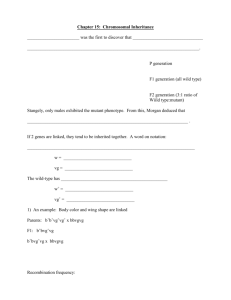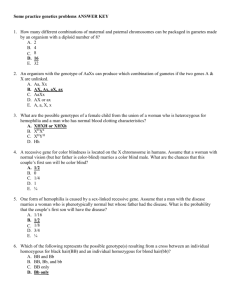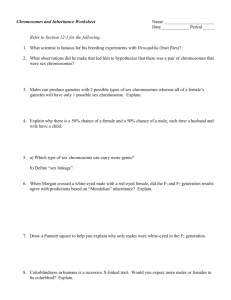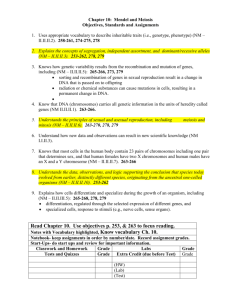Chapter 14 lecture
advertisement
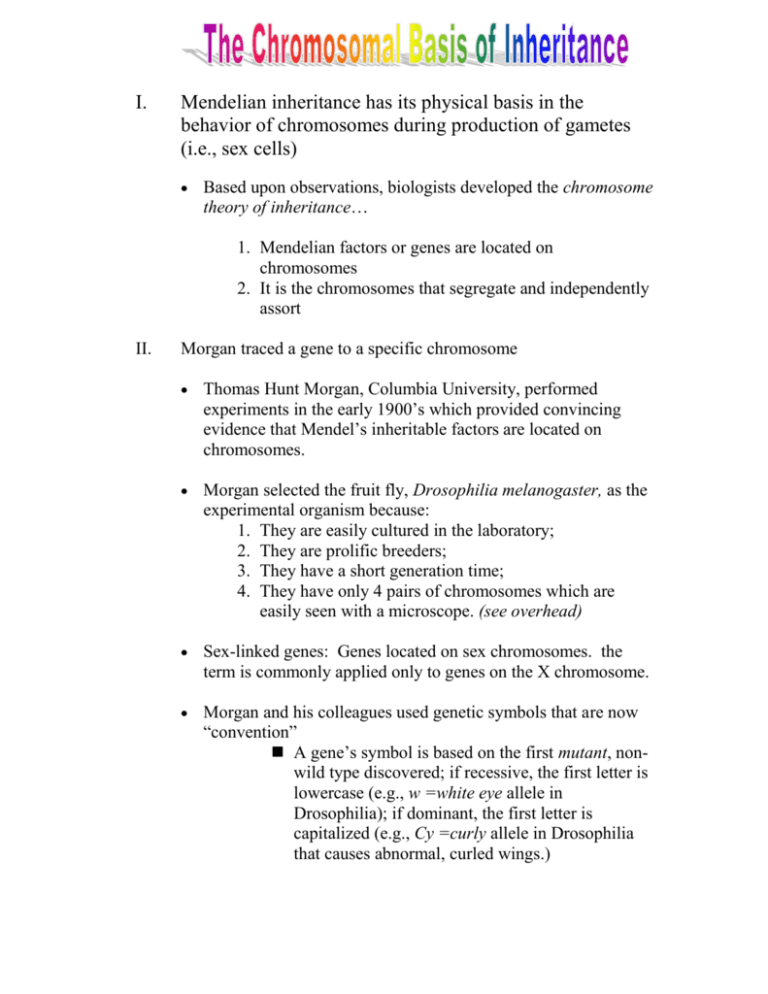
I. Mendelian inheritance has its physical basis in the behavior of chromosomes during production of gametes (i.e., sex cells) Based upon observations, biologists developed the chromosome theory of inheritance… 1. Mendelian factors or genes are located on chromosomes 2. It is the chromosomes that segregate and independently assort II. Morgan traced a gene to a specific chromosome Thomas Hunt Morgan, Columbia University, performed experiments in the early 1900’s which provided convincing evidence that Mendel’s inheritable factors are located on chromosomes. Morgan selected the fruit fly, Drosophilia melanogaster, as the experimental organism because: 1. They are easily cultured in the laboratory; 2. They are prolific breeders; 3. They have a short generation time; 4. They have only 4 pairs of chromosomes which are easily seen with a microscope. (see overhead) Sex-linked genes: Genes located on sex chromosomes. the term is commonly applied only to genes on the X chromosome. Morgan and his colleagues used genetic symbols that are now “convention” A gene’s symbol is based on the first mutant, nonwild type discovered; if recessive, the first letter is lowercase (e.g., w =white eye allele in Drosophilia); if dominant, the first letter is capitalized (e.g., Cy =curly allele in Drosophilia that causes abnormal, curled wings.) the wild type trait is designated by a superscript + (e.g., Cy+ = allele for normal, straight wings.) Wild type: Normal or most frequently observed phenotype Mutant phenotypes: Phenotypes that are alternatives to the wild type and which are due to mutations in the wild-type gene. Discovery of Sex-linked genes After a year of breeding Drosophilia to find variant phenotypes, Morgan discovered a single male fly with white eyes instead of the wild-type red. Morgan mated this white-eyed male with a redeyed female. (see overhead) Morgan deduced that eye color is linked to sex and that the gene for eye color is located only on the X chromosome. Premises for this conclusion were: 1. If eye color is located only on the X chromosome, then females (XX) carry 2 copies of the gene, while males (XY) have only 1 copy. 2. Since the mutant allele is recessive, a white-eyed female must have that allele on both X chromosomes which was impossible for F2 females in Morgan’s experiment. 3. A white-eyed male has no wild-type allele to mask the recessive mutant allele, so a single copy of the mutant allele confers white eyes. III. Linked genes tend to be inherited together because they are located on the same chromosome Genes located on the same chromosome tend to be linked in inheritance and do not assort independently because they are on the same chromosome and move together through meiosis and fertilization. A dihybrid cross following 2 linked genes will not produce an F2 phenotypic ratio of 9:3:3:1. Why? (see overhead) Morgan performed a dihybrid testcross between: b = black body b+ = gray body b+bvg+vg x gray, normal wings IV. vg = vestigial wings vg+ = wild-type wings bbvgvg black, vestigial wings Resulting phenotypes of the progeny did not occur in the expected 1:1:1:1 ratio for a dihybrid testcross. A disproportionately large number of flies had the phenotuypes of the parents: gray with normal wings and black with vestigial wings. Morgan proposed that these unusual ratios were due to linkage. Independent assortment of chromosomes and crossing over cause genetic recombination Genetic recombination: the production of offspring with new combinations of traits different from those combinations found in the parents; results from the events of meiosis and random fertilization. 1. Recombination of unlinked genes: independent assortment of chromosomes Mendel discovered that some offspring from dihybrid crosses have phenotypes unlike either parent. An example is the following cross between pea plants: YY, Yy = yellow seeds yy = green seeds RR, Rr = round seeds rr = wrinkled seeds P generation: YyRr yellow round X yyrr green wrinkled Progeny: ¼ Yy Rr ¼ yyRr green, round ¼ yyrr } Parental types (50%) ¼ Yyrr } Recombinant types (50%) yellow, wrinkled Parental Types: Progeny that have the same phenotype as one or the other of the parents. Recombinants: Progeny whose phenotypes differ from either parent. The genes for seed shape and seed color assort independently of one another because they are located on different chromosomes which randomly align during metaphase of meiosis I. 2. Recombination of Linked Genes: Crossing Over If genes are totally linked, some phenotypic combinations should not appear. Sometimes, however, the unexpected recombinant phenotypes do appear! (see overhead) b = black body b+ = gray body b+bvg+vg X gray, normal wings vg = vestigial wings vg+ = wild-type wings bbvgvg black, vestigial wings Morgan’s results showed that the two genes were neither unlinked nor totally linked. 17% of the progeny were recombinants…the linkage must be incomplete! V. Crossing Over during meiosis accounts for the recombination of linked genes. the exchange of parts between homologous chromosomes breaks linkages in parental chromosomes and forms recombinants with new allelic combinations. Geneticists can use recombination data to map a chromosome’s genetic loci Scientists used the recombination frequencies between genes to map the sequence of linked genes on particular chromosomes. 1. Morgan’s Drosophilia studies showed that some genes are linked more tightly than others. --For example, the recombination frequency between the b and vg loci is 17% --the recombination frequency is only 9% between b and cn, a third locus on the same chromosome (cinnabar eyes) Sturtevant used recombination frequencies between genes to assign them a linear position on a chromosome map. He defined one map unit as 1% recombination frequency, called a centimorgan, in honor of Morgan. Using crossover data, a map may be constructed as follows: 1. Establish the relative distance between those genes farthest apart or with the highest recombination frequency. b---------------------------------------------------vg ------------------17-------------------------- 2. determine the recombination frequency between the third gene (cn) and the first (b). cn---------------b ------9---- 3. Consider the two possible placements of the third gene: a. cn------------b-------------------------------------vg -----9-------------------17--------------- b. b------------cn------------------------------------vg -----9-----------------?------------------ -----------------------17----------------------- 4. Determine the recombination frequency between the third gene (cn) and the second (vg) to eliminate the incorrect sequence. The correct sequence is b----cn----vg; the distance between cn and vg is 17cM – 9 cM = 8 cM. However, the recombination frequency data between cn and vg was 9.5%. What causes this discrepancy? Loci b and vg cn and b cn and vg Recombination Frequency 17.0% 9.05 9.5% Approximate Map Units 18.5 9.0 9.5 Note that there are actually 18.5 map units between b and vg. This is higher than that predicted from the recombination frequency of 17.0%. Because b and vg are relatively far apart, double crossovers occur between these loci and cancel each other out, leading us to underestimate the actual map distance. If genes are so far apart that the recombination frequency is 50%, they are indistinguishable from unlinked genes that assort independently. Linked genes that far apart can be mapped if additional recombination frequencies can be determined between intermediate genes and each of the distant genes Maps based on crossover data only give information about the relative position of linked genes on a chromosome. another technique, Cytological Mapping, pinpoints the actual location of genes and the real distance between them. For practice, try to predict the map of the following testcross results: Loci (Genotypes) Actual Results bvg+/bvg b+vg+/bvg bvg/bvg b+vg/bvg cn and b b and vg vg and cn 156 915 894 135 Recombination Frequency 1. ? Approximate Map Units 2. ? 15% 1. ? 3. ? Recombination Frequency = recombinants total offspring x 100% Answer: 1. R.F.= 291/2100 x 100% = 13.86% 2. 13.86 cM 3. a. cn----------------------------b-----------------vg -------------15----------------13.9-- b. cn-------vg-------------------------------------b --1.1---------------13.9------------- vg and cn could either be 28.9 cM or 1.1 cM apart, further cross data is needed to confirm!
